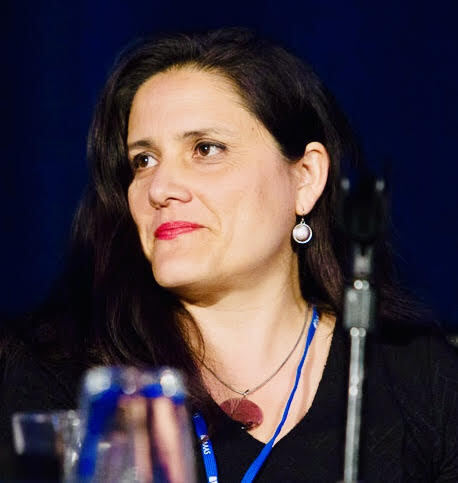
STEM+C3 is an innovative program that works to integrate computer science principles into science and math through pre- and in-service teacher training. We recently interviewed STEM+C3 Director Imelda Nava to find out how she became involved in the program, and how she has used computer science over the years to advance social justice and equity.
HOW DID YOU GET INVOLVED IN COMPUTER SCIENCE EDUCATION?
Imelda: I recently got involved in computer science (CS) education through UCLA's STEM + C3 pathway. I’ve been curious about CS since middle school, and have been tangibly involved in STEM fields, specifically science education, for the last 17 years. As a kid, I remember pressuring my father to purchase a Commodore 64 in the 80s. And, as a student in high school and science major in college, I was exposed to coding and web development.
I remember my high school CS experience well—working alone and inputting code as the green cursor blinked on the black screen. I found the work very tedious, lonely, and absent of relevance, other than contributing to the development of the machine I was seeing the code on. It didn’t get much better in college, however the webpage we developed in class could be a topic of our choice and interest, and I chose to make a page about breast cancer.
As a graduate student, I was able to see the greater relevance of analyzing data, and I began to work on DNA sequencing and statistical analysis toward the construction of phylogenetic trees (evolutionary relationships among organisms). This showed me how data and statistical analysis could tell a story, one that informed a history of origins and relationships between diverse organisms. As I entered different parameters, the story could become more refined, or reveal different insights.
Given these experiences, it’s clear that CS is more critical to the world we live in today—beyond the blinking cursor. It can represent power and a tool to help create a world that addresses injustices, helps cure disease, and provides models to address climate change. More specific to education, the Next Generation Science Standards has embedded computational thinking (CT) into the practices, making the ties to science education clearer.
CAN YOU TELL US MORE ABOUT THE STEM + C3 PROGRAM, AND WHY IT'S SO IMPORTANT?
Imelda: UCLA STEM + C3 is an innovative teacher residency program that integrates both a secondary single subject credential in math or science, and a supplementary authorization in CS. Our approach to CS is grounded in social justice and equity, as we strive to disrupt dominant notions of neutrality in both STEM and CS fields. Instead, we engage in critical analysis of our world through a humanizing lens within the CS and STEM fields.
UCLA STEM + C3 is a federally funded residency grant that adheres to three goals:
These goals are grounded in a foundation of critical analysis of CS and technology in our society with the focus on having our participants, including the K-12 students we work with, be critical consumers as well as creators and innovators of technology toward the public good.
Through STEM + C3 , we engage both pre-service and in-service teachers so they can interrogate their own bias and belief systems to better serve and work with students from traditionally marginalized communities. Further, as teachers, they can facilitate and build accepting environments that allow students to recognize and hold on to their own strengths and identities within STEM systems, one where students can access their agency toward dismantling the existing power dynamics, toward a greater democratization of our society.
WHY IS COMPUTER SCIENCE EQUITY IMPORTANT TO YOU?
Imelda: Our students and in general, people in society, interact with technology in ways that are so integrated into how we live, that they are often taken for granted; they can be silent and useful, or sometimes harmful. However, people from traditionally marginalized communities are not often at the table when creating this technology. There is so much potential that is often not considered, seen, or supported. These perspectives are often absent from the design and purpose of many of these CS tools. Having traditionally marginalized populations have access to these tools so they can create and not only consume, is one aspect of the work.
However, beyond access, what are these tools being used for? Critical analysis and knowledge of these tools allows for discussion about the complexity of how these tools are being used and for what purpose. I want to create environments where students can connect CS to their interests and purpose.
Today’s dependence, confinement, surveillance, and oppression with technology can be critiqued, analyzed and shifted to be a tool for empowerment and service for the greater good on a local, national, and global scale. CT and data analysis are a basic literacy and empowerment tool that, once literate, can allow people to be critical consumers and creators. CT and data analysis are tools of power, individually, locally, and globally. The most marginalized voices and approaches must be at the table.
WHAT ADVICE WOULD YOU GIVE A TEACHER LOOKING TO GET INTO COMPUTER SCIENCE?
Imelda: I would advise them to, if interested, have the energy and passion to get started. Many of our teacher candidates do not have formal experience in CS, but have been surrounded and immersed by it. I’m excited for CS supplementary authorization to eventually be offered for all content areas, beyond math and science teachers. This will strengthen the conversation and perspectives within the CS world. CS and CT impact all aspects of our lives, and will be enriched by the people, experiences, and critical thought and questions that contribute to it.